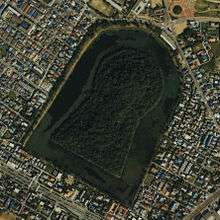Emperor Richū
| Richū | |
|---|---|
| Emperor of Japan | |
| Reign | 400–405 (traditional)[1] |
| Predecessor | Nintoku |
| Successor | Hanzei |
| Born | 336 |
| Died | 405 (aged 69) |
| Burial | Mozu no Mimihara no naka no misasagi (Osaka) |
Emperor Richū (履中天皇 Richū-tennō) was the 17th emperor of Japan,[2] according to the traditional order of succession.[3]
No firm dates can be assigned to this emperor's life or reign, but he is conventionally considered to have reigned from 400 to 405.[4]
Legendary narrative
Richū is regarded by historians as a "legendary emperor" of the 5th century.[5] The reign of Emperor Kinmei (c. 509 – 571 AD), the 29th emperor,[6] is the first for which contemporary historiography is able to assign verifiable dates;[7] however, the conventionally accepted names and dates of the early emperors were not to be confirmed as "traditional" until the reign of Emperor Kanmu (737–806), the 50th sovereign of the Yamato dynasty.[8]
According to Nihonshoki and Kojiki, Richū was the eldest son of Emperor Nintoku and Iwanohime.
Richū's contemporary title would not have been tennō, as most historians believe this title was not introduced until the reigns of Emperor Tenmu and Empress Jitō. Rather, it was presumably Sumeramikoto or Amenoshita Shiroshimesu Ōkimi (治天下大王), meaning "the great king who rules all under heaven." Alternatively, Richū might have been referred to as (ヤマト大王/大君) or the "Great King of Yamato."
Some scholars identify him with King San in the Book of Song. King San sent messengers to the Liu Song dynasty at least twice in 421 and 425.[9]

Richū escaped from Naniwa Place to Isonokami Shrine because of arson.[10] Richū succumbed to disease in his sixth year of reign. His tomb is in Kawachi province, in the middle of present-day Osaka Prefecture. He was succeeded by his younger brother Emperor Hanzei. None of his sons succeeded to the throne, although two grandsons would eventually ascend as Emperor Kenzō and as Emperor Ninken.
The site of Richū's grave is not known.[2] This emperor is traditionally venerated at a memorial Shinto shrine (misasagi) in Sakai, Osaka. The Imperial Household Agency designates this location as Richū's mausoleum. It is formally named Mozu no mimihara no minami no misasagi.[11] It is also identified as the Kami Ishizu Misanzai kofun.
Consorts and children
Empress (first): Kurohime (黒媛), daughter of Katsuragi no Ashita no Sukune (葛城葦田宿禰)
- Prince Iwasaka no itinohe no Oshiha (磐坂市辺押磐皇子), father of Emperor Kenzō and Emperor Ninken
- Prince Mima (御馬皇子)
- Princess Aomi no Himemiko (青海皇女)
Empress( second): Kusaka no Hatabi no Himemiko (草香幡梭皇女), daughter of Emperor Ōjin
- Princess Nakashi no Himemiko (中磯皇女), wife of Ookusaka
Futohime no Iratsume (太姫郎姫), daughter of Funashiwake (鯽魚磯別王)
Takatsuru no Iratsume (高鶴郎姫), sisters of Futohime
See also
Notes

- ↑ "Genealogy of the Emperors of Japan" at Kunaicho.go.jp; retrieved 2013-8-28.
- 1 2 Imperial Household Agency (Kunaichō): 履中天皇 (17); retrieved 2013-8-28.
- ↑ Titsingh, Isaac. (1834). Annales des empereurs du japon, pp. 24–25; Brown, Delmer M. (1979). Gukanshō, p. 257; Varley, H. Paul. (1980). Jinnō Shōtōki, p. 111.
- ↑ Ponsonby-Fane, Richard. (1959). The Imperial House of Japan, p. 38.
- ↑ Kelly, Charles F. "Kofun Culture", Japanese Archaeology. 27 April 2009.
- ↑ Titsingh, pp. 34–36; Brown, pp. 261–262; Varley, pp. 123–124.
- ↑ Hoye, Timothy. (1999). Japanese Politics: Fixed and Floating Worlds, p. 78; excerpt, "According to legend, the first Japanese emperor was Jinmu. Along with the next 13 emperors, Jinmu is not considered an actual, historical figure. Historically verifiable Emperors of Japan date from the early sixth century with Kinmei.
- ↑ Aston, William. (1896). Nihongi, pp. 109.
- ↑ Aston, William. (1998). Nihongi, Vol. 1, pp. 301–311.
- ↑ Nihon Shoki, Chapter 12
- ↑ Ponsonby-Fane, p. 419.
References
- Aston, William George. (1896). Nihongi: Chronicles of Japan from the Earliest Times to A.D. 697. London: Kegan Paul, Trench, Trubner. OCLC 448337491
- Brown, Delmer M. and Ichirō Ishida, eds. (1979). Gukanshō: The Future and the Past. Berkeley: University of California Press. ISBN 978-0-520-03460-0; OCLC 251325323
- Ponsonby-Fane, Richard Arthur Brabazon. (1959). The Imperial House of Japan. Kyoto: Ponsonby Memorial Society. OCLC 194887
- Titsingh, Isaac. (1834). Nihon Ōdai Ichiran; ou, Annales des empereurs du Japon. Paris: Royal Asiatic Society, Oriental Translation Fund of Great Britain and Ireland. OCLC 5850691
- Varley, H. Paul. (1980). Jinnō Shōtōki: A Chronicle of Gods and Sovereigns. New York: Columbia University Press. ISBN 978-0-231-04940-5; OCLC 59145842
External links
| Regnal titles | ||
|---|---|---|
| Preceded by Emperor Nintoku |
Emperor of Japan: Richū 400–405 (traditional dates) |
Succeeded by Emperor Hanzei |
